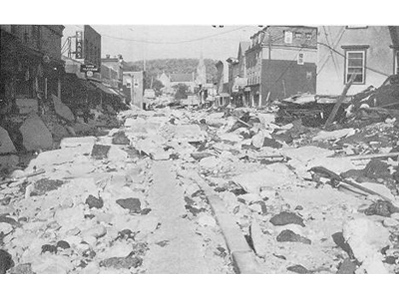Hurricane Diane was one of three hurricanes to hit the North Carolina coast during the 1955 Atlantic hurricane season. The system began as a tropical wave over the Atlantic Ocean, which developed into a tropical depression on August 7, 1955. Moving in a west-northwest motion, the depression became Tropical Storm Diane two days later. The storm turned north-northeast on 11 August and quickly developed into a hurricane about 645 km (400 mi) northeast of San Juan, Puerto Rico. The hurricane reached its peak intensity at Category 3 status on 12 August with 193 km/h (120 mph) sustained winds. It retained Category 3 status for three days until cooler air behind Hurricane Connie, a Category 1 hurricane that struck the Outer Banks of North Carolina on 12 August, became entrained in Diane’s circulation. As a result, Hurricane Diane weakened to Category 1 strength with winds of 119 km/h (74 mph) before making landfall in the southeast part of North Carolina, near Wilmington, NC on 17 August. At the time of landfall, Diane had sustained wind speeds of 80 km/h (50 mph), and the only areas that were experiencing hurricane force winds were a few exposed points on the coast between Cape Hatteras and Cape fear, NC. Diane’s landfall occurred just 241 km (150 mi) southwest from Hurricane Connie’s point of landfall near Cape Lookout five days earlier, leaving residents of these areas with little time to prepare due to the close proximity of the two storms.
Hurricane Diane continued to weaken as it moved over Raleigh, NC, and into Virginia, where maximum wind speeds were 56 km/h (35 mph). The storm then turned toward the northeast, where its heavy rains produced devastating floods. The system moved past Philadelphia, PA, off the New Jersey coast, and then paralleled the southern New England coast as a tropical storm before becoming extratropical south of Nova Scotia, Canada on 20 August. Rainfall from Hurricane Connie had saturated the ground and significantly raised water levels as it moved through central coastal NC five days prior to the arrival of Hurricane Diane. Although Connie did not produce significant flooding, it set the stage for Hurricane Diane to create some of the most destructive floods the river valleys of eastern Pennsylvania, northwest New Jersey, southeast New York and southern New England had ever seen. Rainfall amounted to 510 mm (20 in) in New England over the two-day period when Diane was a tropical storm off the Northeast coast. The state of Connecticut received the most rainfall, especially in areas north and west of Hartford, with up to 305 mm (12 in) of rainfall in 24 hours. As a result, losses from Hurricane Diane were greatest in Connecticut- damages amounted to $350 million (1955 USD) in CT alone and 77 lives were lost. Other areas also incurred significant damage. The city of Woonsocket, RI was heavily damaged as a dam broke to the north west of the city, pushing a 6.1 m (20 ft) wall of water down the Blackstone River. That river, normally 21.3 m (70 ft) wide, swelled to 1.6 km (1 mile) in width during the flooding event. Overall, 184-200 total fatalities were estimated to be a result of Hurricane Diane. Although it was difficult to estimate total damages stemming from Hurricane Diane at first (as the magnitude of the storm was so great), it was determined that the floods and other impacts from the hurricane caused between $832 million and $1 billion (1955 USD) in damage, making it the costliest hurricane in U.S. history at the time (until it was surpassed by Hurricane Betsy in 1965). Fast Facts:
Sources:
Dunn, G.E., Davis, W.R., and Moore, P.L. 1955. Hurricanes of 1955. Monthly Weather Review. 315-326. Barnes, Jay. North Carolina’s Hurricane History. Chapel Hill: UNC Press, 1998. Pp. 110-114. Preliminary Report of Hurricane Diane And Floods in the Northeast. United States Department of Commerce Weather Bureau. 25 Aug. 1955. Web. Dunn, Gordon and Banner Miller. Atlantic Hurricanes. Louisiana State University Press, 1964. Pp. 221, 224, 229. The Floods of Hurricane Connie and Diane. NOAA. 2009. Hurricane Diane. Wikipedia. 2009. Jill, John. “A Decade of Disasters And A Retailing Revolution.” Providence Journal. 26 Jul. 1999. Web. Blackstone River. Wikipedia. 2009. < http://en.wikipedia.org/wiki/Blackstone_River> |


